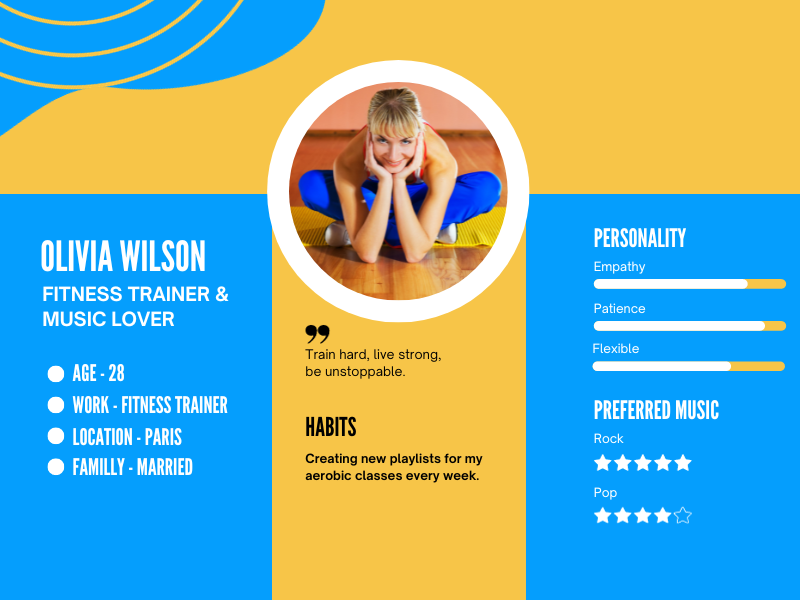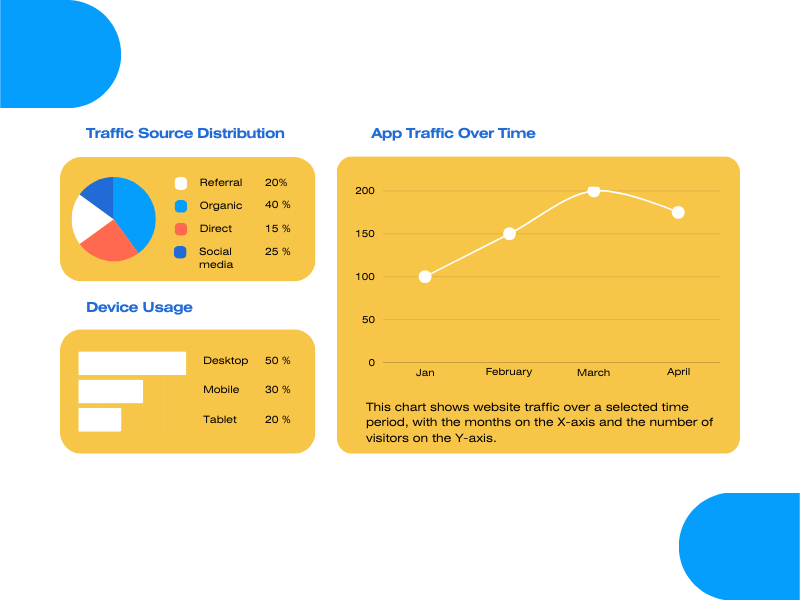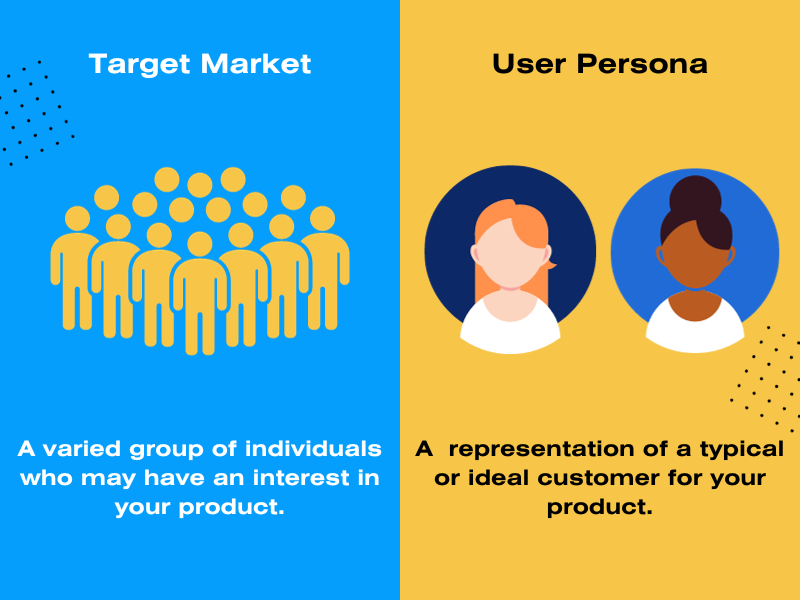
User personas are detailed descriptions of the ideal customers that a product or service aims to attract. They are valuable because they help you gain a deeper understanding of your audience.
To create the profiles of your customers, you collect and organize information about their preferences, behaviors, and needs.
However, creating user personas can be a bit of a headache. Don’t worry though, this article is here to make creating effective personas a breeze.
You’ll learn what user personas are, and most importantly, how to create them confidently and without any stress.
To help illustrate my points, I will be giving examples based on a music app product. Let’s start.
Step 1. Find the purpose behind creating user personas
Before I create a user persona, I like to determine why I want to create it. Specifically, I ask myself what I want to achieve with my product, to make sure my reasons align with the goals of the company.
So, my product goals could be to improve user engagement, tailor features to specific needs, or target a particular audience segment.
Let’s dive into each.
Improving User Engagement
If my objective is to enhance user engagement, I like to create user personas to understand what motivates users to interact with my music app, what features they find most appealing, and how I can tailor their experience to keep them engaged.
Tailoring Features
If I aim to customize or develop new features for my music app, user personas can be really helpful in providing insights into the needs, preferences, and pain points of different user segments. This information can guide feature prioritization and design.
Targeting Specific User Segments
User personas are valuable when I want to target specific audience segments with tailored marketing, content, or promotions. They help me understand the demographics, interests, and behaviors of these segments.
Now let’s look at an example:
Let’s say my music app’s objective is to increase user retention rates among millennials. In this case, my objective for creating user personas could be to better understand the music preferences, listening habits, and user journeys of millennial users.
This understanding would enable me to design features and content that resonate specifically with this demographic, ultimately leading to improved retention rates.
Step 2. Use Data and Insights to Create Personas
Getting to know what my users like, how they use my app, and what they need is very important. So, I send out surveys, schedule interviews, and analyze the app usage to gather information that will help me create their user profile.
From surveys and interviews, I might find out that one group of users likes to use my app for working out, while another group likes to use it for relaxing.

From analyzing the app usage, I can identify different patterns, such as how often they listen to music, when are they most active, and which features they frequently use. I can understand their click paths, where they spend the most time, and what actions they take.
Below is an example of types of data you can collect and analyze:

Step 3. Define The Problem
Before I can solve a problem, I take a close look at the data I’ve gathered and see if there are any patterns that emerge. Once I’ve organized and categorized all these insights, I can then move on to understanding what users are struggling with and why.
After that, I can come up with a solution that addresses the root cause of the problem and makes things easier for everyone.
When creating a problem statement, it’s important to be specific. Instead of just identifying a broad issue, I try to get as granular as possible. This means that I focus on the details and try to pinpoint exactly what the problem is and how it’s affecting users.
So, instead of saying that the issue with the app is that users have trouble with it in general I could say something more specific – like users are having trouble discovering new music.
I frame the problem statement from a user-centric perspective. It should reflect a challenge that impacts the users’ experience and satisfaction with the app. One such problem could be, ‘Users often struggle to discover new and exciting musing, leading to frustration and a less enjoyable music exploration experience in my app.
Now that I understand the specific problems users face, I can tailor the personas to address these challenges. If discovering new music is a common issue, I will include characteristics related to music discovery in the personas.
Step 4. Craft User Personas
Let’s take a look at the following user persona example. Based on the details I’ve gathered in the previous steps I can create user personas such as “Music Enthusiast Emily” and “Casual Listener Alex.”
These personas should include specific details like age, location, music genre preferences, listening habits, and motivations.
For instance, Emily could be a 28-year-old music lover who likes exploring indie and alternative rock music. She likes to create and share playlists to connect with like-minded people.
On the other hand, Alex could be a 35-year-old casual listener who primarily uses the app during his daily commute. He prefers personalized playlists and easy navigation.
Step 5. Constantly Refine And Update User Personas
When it comes to creating and updating user personas, it’s really important to keep in mind that it’s a continuous process. This means that I’m always gathering more data and insights, and adapting my personas accordingly to make sure they’re up-to-date and effective.
In case I notice a shift in user behavior or preferences, I make sure to update my personas to reflect these changes. By doing this, I can ensure that my personas remain relevant and helpful in guiding the development of the product or service.
At the end of the day, my ultimate goal is to create personas that truly represent the users and their needs. This way, I can continue to provide them with the best experience possible.
When To Create New User Personas?
Creating user personas can be a really valuable tool for a variety of scenarios.
For example, if I have a diverse user base with varying needs and goals, personas can help me better understand each user segment and tailor my product to meet their specific needs.
In addition to this, if I want my design and development decisions to align with user expectations, personas can help me stay on track and create products that resonate with my users.
Furthermore, user personas are great for improving user-centered design. By creating personas that reflect the users’ needs, preferences, and behaviors, I can design a product that meets their needs and exceeds their expectations.
Lastly, if my project or product is particularly complex, user personas can provide me with a deeper understanding of my users, making it easier to create a product that meets their specific needs.
When To Update Existing User Personas?
Even if user personas are already created, it’s important to remember that they should be living documents that evolve along with the understanding of the users and the product.
This means that updating my personas can be really beneficial, especially if I’ve gathered new data or if there have been significant changes in my product or user base.
There are a few different scenarios when updating user personas can be particularly helpful.
- If my users’ behavior or preferences have evolved, it’s essential to update my personas to reflect these changes accurately.
- Similarly, when I introduce new features or products, I may need to adjust my personas to incorporate these changes and align them with user needs related to these additions.
- If I receive feedback from users that highlights unaddressed pain points or new challenges, updating my personas can help me create solutions that cater to these issues.
- Additionally, external factors like shifts in the market, industry trends, or competition can impact my users. Updating my personas can help me adapt to these changes and better understand my users’ needs in light of new developments.
- Finally, if I conduct new research, interviews, or surveys that provide deeper insights into my users, refining my personas based on the newly acquired knowledge can be really helpful.
Overall, updating my personas can help ensure that they remain accurate and effective in guiding my product development decisions
Is It Mandatory to Always Create User Personas?
While creating user personas can be super helpful, it’s not always necessary. Here are some scenarios where I might choose not to develop user personas:
- If I have very limited time, budget, or human resources, I might opt for a more streamlined approach that excludes detailed persona development.
- For products that cater to an extremely niche or specialized audience, the need for personas may be reduced.
- If I have a well-established and well-defined target audience, and I’ve already collected substantial user data and feedback, creating personas might not add significant value.
- During the early stages of a project where the objectives are exploratory or speculative, creating detailed user personas might be premature.
- For straightforward, single-feature products, the creation of detailed personas might be overkill.
Tip: Ultimately, the decision to create personas should be based on the specific needs of the project and the available resources.
Is creating user personas the same as determining the market for a new product?
It is not the same. When you’re determining the market for a new product, it’s important to take a more market-centric approach. You need to look at a broader audience or potential customer base and identify a target market segment that the new product will serve.
This involves conducting market research, competitor analysis, and customer surveys to understand the needs, preferences, and behaviors of the target market.
The ultimate goal is to identify an unmet need in the market and create a new product or solution to address that need effectively.

On the other hand, user personas for an existing product focus on optimizing and catering to your current user base. You can use the data and insights you’ve gathered from your users to create personas that reflect their needs, preferences, and behaviors.
This helps you understand their pain points and create features or solutions that meet their needs. In summary, both processes are valuable but serve different purposes in product development.
While user personas for an existing product help you cater to the needs of your current user base, determining the market for a new product involves broader market research and innovation to identify opportunities for a product that doesn’t exist yet.
Final thoughts
It’s important to remember that user personas are not static documents. They should evolve and adapt as your product and user base grow and change.
Regularly revising and updating your personas will help ensure they remain relevant and effective. By doing so, you’ll be better equipped to make informed decisions and create user-centered designs that meet the unique needs of your target audience.
Creating effective personas is an ongoing journey, one that requires practice and a commitment to understanding your users.

